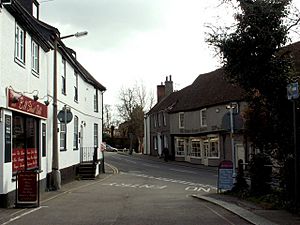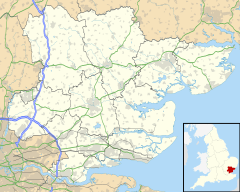Great Baddow facts for kids
Quick facts for kids Great Baddow |
|
|---|---|
 Bell Street, Great Baddow |
|
| Population | 14,650 (2011 Census) |
| OS grid reference | TL731052 |
| Civil parish |
|
| District | |
| Shire county | |
| Region | |
| Country | England |
| Sovereign state | United Kingdom |
| Post town | CHELMSFORD |
| Postcode district | CM2 |
| Dialling code | 01245 |
| Police | Essex |
| Fire | Essex |
| Ambulance | East of England |
| EU Parliament | East of England |
Great Baddow is a large village and civil parish in the Chelmsford borough of Essex, England. It is very close to the city of Chelmsford. With more than 13,000 people living there, it is one of the biggest villages in the country.
Contents
History of Great Baddow
What's in a Name?
The name Great Baddow probably comes from the River Beadwan. This river is now called the River Chelmer. It forms the northern edge of the village. Beadwan is thought to be an old Celtic word. Its exact meaning is not clear, but it might mean birch stream. It could also be linked to a goddess named Badb.
Early Times and Important Owners
During the time of the Anglo-Saxons, important families owned the land of Great Baddow. The Earls of Mercia were among them. Later, in the 1200s, Robert de Brus, 5th Lord of Annandale owned it. After he died, the land eventually went to the King. Henry VIII later gave it to his wife, Catherine of Aragon.
Schools and Growth
Education became important in Great Baddow. In 1731, Jasper Jeffrey started the Great Baddow Free School. Later, in 1830, two National Schools were built. By 1933, the village had many schools, including daily and boarding schools.
Great Baddow grew a lot over time. In 1801, about 1,445 people lived there. By 1841, this number had grown to 2,022. An old book from 1848 described Great Baddow as 'one of the handsomest villages in Essex'. It had 'many scattered farms and neat houses'. The village also had a fun annual fair every year on May 14.
Famous People and Local Life
William Calcraft, a famous hangman and a cobbler (shoe repairer), was born in Baddow in 1800.
In the past, local parishes helped people who were poor. But after a new law in 1834, this job moved to bigger groups called Unions. Great Baddow's poor were looked after by the Chelmsford Union from 1835.
An old directory from 1851 lists many jobs in Great Baddow. There were 24 farmers, 8 beer sellers, 4 shoemakers, and 3 blacksmiths. This shows how many different people lived and worked in the village.
The Great Baddow Mast
The Great Baddow Mast is a very tall tower. It used to be a Chain Home radar transmitter. This type of radar helped protect Britain during World War II. The tower was moved to Great Baddow around 1954. Today, BAE Systems uses it for testing equipment. It is the last tower of its kind that still has its original platforms. Because it is so important, it was made a listed building in 2019. This means it is protected for its historical value.
What to Do in Great Baddow (Amenities)
Local Services
In 1967, a fire station opened in Great Baddow. It replaced an older station. This new station helps keep the village safe.
Great Baddow has three pubs where people can relax: the White Horse, Blue Lion, and The Star. Some other pubs, like The Beehive and King's Head, have closed. The village also has a family-run brewery called the Chelmsford Brewing Company. An old brewery building from 1868 is now a protected building. It is used by local businesses. You can also find the Pontlands Park Country Hotel and the Baddow Antique Centre here.
Protected Areas and Development
The middle of Great Baddow is now a special conservation area. This means its historic buildings and character are protected. There are more than 30 listed buildings in this area.
In the early 1900s, Great Baddow grew outwards towards Chelmsford and Galleywood. In 1936, Marconi's Wireless Telegraph Company opened a big research lab in Great Baddow. This lab brought together many scientists working on radio, TV, and phones. As technology grew, the lab expanded to include radar and other electronics research.
Great Baddow grew a lot in the 1950s. Many new homes were built, especially the Rothmans Estate. These homes were for people working at Marconi's and other companies in Chelmsford. The village has kept growing since then.
The Vineyards, in the old part of the village, used to be a large house with gardens. It became a hotel, but was taken down in the 1960s. A shopping center and an office building called Marrable House were built there. Marrable House was a six-story office block. It was once called one of England's ugliest buildings! It was taken down in 2016. Now, a new apartment complex called Heron Gate stands there. A small green area from the old Vineyards grounds was kept. A new library also opened nearby in 1981.
Great Baddow's Landscape (Geology)
Great Baddow is on higher ground southeast of Chelmsford. This area might have been the edge of a huge ice sheet during the Anglian glaciation (a very old ice age). Under the village, there is a large area of sand and gravel. In the past, this sand and gravel was dug out from several pits. You can still see some of these areas today, like where Beehive Pit used to be. The ground here is made of different layers, including sand, gravel, and London Clay. A large Sarsen stone (a type of sandstone boulder) from the Beehive Pit used to stand outside The Beehive pub.
Schools in Great Baddow (Education)
Great Baddow has a secondary school called Great Baddow High School. It is a sports and science college. There are also several primary schools in the village. These include Baddow Hall Infant and Junior Schools, Beehive Lane County Primary School, Larkrise Primary School, and Meadgate County Primary Schools.
Nearby Villages
Images for kids
-
The former Chain Home radar transmitter tower, in the grounds of BAE Systems Applied Intelligence Laboratories, Great Baddow.



